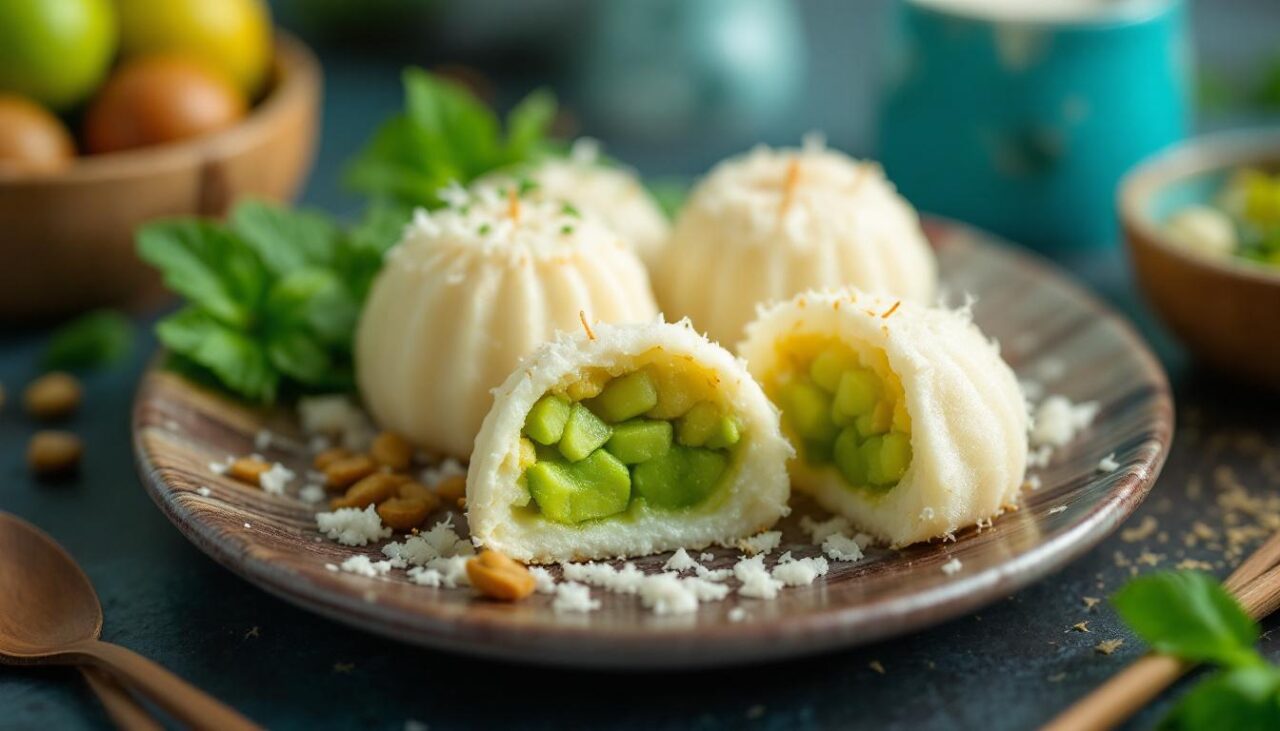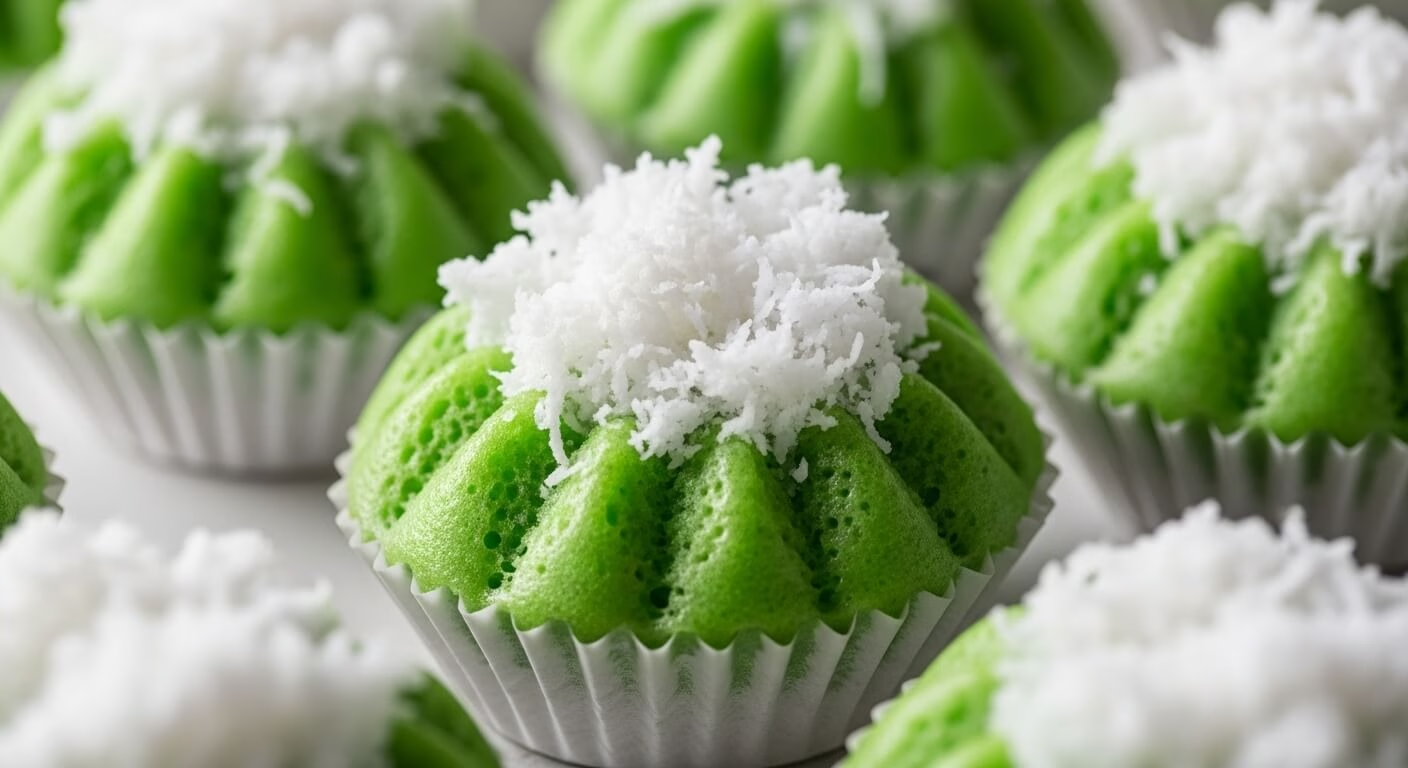Easy Putu Ayu Indonesian Steamed Coconut Pandan Cakes Recipe
Easy Putu Ayu (Indonesian Steamed Coconut Pandan Cakes) Recipe – Let me tell you about the time I first encountered putu ayu at a friend’s Indonesian grandmother’s house, and how it completely changed my understanding of what a cake could be.

Putu Ayu Indonesian Steamed Coconut Pandan Cakes
Ingredients
- 2 pandan leaves (cut into 1 cm. pieces)
- 2 cups coconut (freshly grated, or desiccated)
- 1 tablespoon palm sugar (or coconut sugar, or brown sugar)
- ¼ teaspoon salt
- 1 ¼ cup coconut milk
- 3 pandan leaves (cut into 1 cm. pieces)
- 1 ½ cups all-purpose flour
- 1 teaspoon baking powder
- ¼ teaspoon baking soda
- ⅔ cup sugar
- ½ teaspoon vanilla extract
- ½ teaspoon salt
Instructions
- Preheat a large steamer over medium heat.
- Place the pandan leaf in a blender or spice grinder and blend until finely chopped.
- Add grated coconut and your choice of sugar to the blended pandan, then pulse a few more times to combine. Set aside.
- Place the coconut milk and pandan leaves in a blender and blend for 90 seconds until completely pureed.
- Pass the pureed pandan-scented coconut milk through a wire mesh strainer and compost the remaining pandan pulp.
- In a mixing bowl, combine the strained pandan milk with flour, baking powder, baking soda, baking powder, sugar, vanilla extract, and salt. Whisk until smooth.
- If using metal cake molds, lightly oil them with any neutral-tasting oil. There is no need to oil silicone molds, as they are naturally nonstick and easy to unmold.
- Place a tablespoon of grated coconut topping in the bottom of each cake mold.
- Spoon the cake batter into the molds, filling them two-thirds full.
- Steam the cakes for 30-35 minutes until firm. Unmold after they cool for ten minutes and serve.
Nutrition
I was expecting something Western and familiar – you know, the kind of cake that comes from an oven, golden and crumbly.
Instead, what I got was this ethereal, jade-green little dome that seemed to glow from within, sitting prettily in what looked like a tiny flower pot.
The texture was unlike anything I’d ever experienced – tender and bouncy, almost like a cross between a muffin and a sponge, but somehow more delicate than either.
The first bite was a revelation.
The subtle, grassy sweetness of pandan hit first, followed by the rich creaminess of coconut that seemed to melt on my tongue.
It wasn’t overly sweet like many Western desserts, but had this perfect balance that made me reach for another piece before I’d even finished the first.
The grandmother, watching my obvious delight with twinkling eyes, explained that these were putu ayu – literally “beautiful princess” cakes – and that they were steamed, not baked.
Steamed!
Who knew that steam could create something so wonderful?
I left that day with a hastily scribbled recipe on a napkin and a burning desire to master this Easy Putu Ayu (Indonesian Steamed Coconut Pandan Cakes) recipe in my own kitchen.
That was three years ago, and I’ve been perfecting my technique ever since.
These little green gems have become my go-to dessert when I want something special but not overwhelming, something that feels both exotic and comforting at the same time.
How to Make Authentic Putu Ayu at Home
Putu ayu holds a cherished place in Indonesian cuisine, particularly in Java and other regions where pandan grows abundantly.
The name itself tells you everything you need to know about how beloved these cakes are – “putu” refers to a type of steamed cake, while “ayu” means beautiful or pretty.
Together, they create the perfect description for these stunning little green cakes that look almost too pretty to eat.
The magic of this Easy Putu Ayu (Indonesian Steamed Coconut Pandan Cakes) recipe lies in its simplicity and the unique cooking method.
Unlike Western cakes that rely on the dry heat of an oven to create structure, putu ayu gets its tender, moist texture from gentle steaming.
This creates a cake that’s incredibly light yet satisfying, with a texture that’s almost impossible to replicate through any other cooking method.
The pandan leaves – often called the “vanilla of Southeast Asia” – provide both the signature green color and a subtle, almost floral flavor that’s completely unique.
- Christmas Pudding Flapjack Recipe: The Holiday Leftover Hero You Need
- Perfect Simple Pancakes Recipe – Easy & Delicious
- Salted Caramel Cheescake Recipe
- Perfect Pisang Goreng Recipe – Crispy Indonesian Fried Bananas
- Classic British Bakewell Tart Recipe | Almond & Raspberry
- Chocolate Avocado Mousse Recipe | Healthy Dessert
Combined with coconut milk in the batter and grated coconut on top, these cakes embody the tropical flavors that make Indonesian desserts so distinctive and memorable.
Ingredients You’ll Need
Gathering ingredients for this Easy Putu Ayu (Indonesian Steamed Coconut Pandan Cakes) recipe is half the adventure, especially if you’re new to Southeast Asian cooking.
The star of the show is definitely the pandan leaves – you’ll need 5 leaves total, split between the coconut topping and the cake batter.
For the Coconut Topping:
- 2 pandan leaves, cut into 1-cm pieces
- 2 cups freshly grated coconut (or desiccated coconut)
- 1 tablespoon palm sugar (coconut sugar or brown sugar work too)
- ¼ teaspoon salt
For the Cake Batter:
- 1¼ cups coconut milk
- 3 pandan leaves, cut into 1-cm pieces
- 1½ cups all-purpose flour
- 1 teaspoon baking powder
- ¼ teaspoon baking soda
- ⅔ cup sugar
- ½ teaspoon vanilla extract
- ½ teaspoon salt
Step-by-Step Instructions
Making this Easy Putu Ayu (Indonesian Steamed Coconut Pandan Cakes) recipe is surprisingly straightforward once you get the hang of it.
The key is working in stages and not rushing the process – good things come to those who steam!
Setting Up Your Steaming Station
Start by getting your steamer ready and heating over medium heat.
If you don’t have a traditional steamer, don’t panic!
You can easily improvise with a large pot and a steaming rack, or even use a bamboo steamer if you have one.
The important thing is creating a consistent, gentle steam environment.
Preparing the Coconut Topping
Place 2 pandan leaves in your blender or spice grinder and blend until they’re finely chopped – you want them almost powdery.
This releases all those wonderful aromatic oils that make pandan so special.
Add your grated coconut and palm sugar to the chopped pandan, then pulse a few times to combine everything evenly.
The mixture should look like green-flecked coconut snow.
Set this aside – it’s going to be the crowning glory of your cakes.
Creating the Pandan-Infused Batter
Here’s where the magic really happens.
Combine 1¼ cups coconut milk with 3 pandan leaves in your blender and blend for a full 90 seconds.
Don’t skimp on this time – you want those leaves completely pureed to extract maximum flavor and color.
The mixture should turn a beautiful pale green.
Strain this pandan-coconut milk through a fine wire mesh strainer, pressing the pulp to extract every bit of liquid.
Compost the remaining pulp – you’ve gotten all the good stuff out of it.
In a mixing bowl, combine your strained pandan milk with flour, baking powder, baking soda, sugar, vanilla extract, and salt.
Whisk until the batter is completely smooth with no lumps.
The consistency should be similar to pancake batter – pourable but not too thin.
Assembly and Steaming
If you’re using metal molds, give them a light coating of neutral oil.
Silicone molds don’t need any prep – they’re naturally non-stick and perfect for this recipe.
Place a tablespoon of your coconut topping in the bottom of each mold.
This creates that beautiful two-toned effect when you flip the cakes out.
Fill each mold about two-thirds full with batter – they’ll puff up during steaming, so don’t overfill.
Steam for 30-35 minutes until the cakes feel firm to the touch.
Let them cool for about 10 minutes before unmolding – this prevents them from falling apart while they’re still too delicate.
Pro Tips for Perfect Putu Ayu
After making this Easy Putu Ayu (Indonesian Steamed Coconut Pandan Cakes) recipe countless times, I’ve learned a few tricks that make all the difference.
Getting the Best Pandan Flavor
Fresh pandan leaves are absolutely worth seeking out if you can find them at Asian markets.
They provide both better color and more complex flavor than pandan extract.
If you can only find extract, use about 1 teaspoon in place of the fresh leaves, but know that the color won’t be quite as vibrant.
Coconut Considerations
Freshly grated coconut is ideal, but don’t stress if you can only find desiccated coconut.
Just make sure it’s unsweetened – you want to control the sweetness level yourself.
If your desiccated coconut seems very dry, you can sprinkle it lightly with water and let it sit for 10 minutes to rehydrate slightly.
Steaming Success
Maintain consistent medium heat throughout the steaming process.
Too high and the cakes might cook unevenly; too low and they won’t set properly.
Make sure your steamer lid fits tightly to maintain proper steam circulation.
Texture Troubleshooting
If your cakes turn out dense, you might have overmixed the batter or your leavening agents might be old.
Baking powder and baking soda lose their potency over time, so check expiration dates.
If they seem gummy, you may have steamed them too long or at too high heat.
Creative Variations to Try
Once you’ve mastered the basic Easy Putu Ayu (Indonesian Steamed Coconut Pandan Cakes) recipe, there are so many fun ways to mix things up.
Flavor Variations
Try substituting half the pandan with other Southeast Asian flavors like ube (purple yam) for a stunning purple version, or add a tablespoon of matcha powder for a Japanese-Indonesian fusion.
You could even go tropical with a bit of mango puree mixed into the batter.
Topping Adventures
While traditional coconut topping is classic, consider mixing in some toasted sesame seeds, chopped peanuts, or even a sprinkle of black sesame for visual drama.
A light dusting of powdered sugar just before serving adds an elegant touch.
Size and Shape Options
These work beautifully in mini muffin tins for bite-sized treats perfect for parties, or you can make one large cake in a bundt pan (just increase steaming time to about 45-50 minutes).
Individual ramekins create an elegant presentation for dinner parties.
Modern Twists
For a contemporary take, try layering the batter with the coconut mixture for a marbled effect, or add a surprise center of sweetened mung bean paste or even a small piece of dark chocolate.
What to Expect When You Make These
Let me be completely honest about what you’re getting into with this Easy Putu Ayu (Indonesian Steamed Coconut Pandan Cakes) recipe – because setting realistic expectations is half the battle in any new cooking adventure.
First, don’t expect these to taste like any Western cake you’ve ever had.
They’re not meant to be super sweet or rich.
Instead, they offer a subtle, sophisticated flavor that grows on you with each bite.
The texture is uniquely bouncy and tender – think somewhere between a sponge cake and a steamed bun, but lighter than either.
Your first batch might not be perfect, and that’s completely okay!
The color might be paler than you expected (especially if using extract instead of fresh pandan), or the texture might be slightly different from what you imagined.
Each steamer behaves differently, and it might take a batch or two to figure out your optimal timing and heat level.
The beautiful thing about this recipe is that even “imperfect” putu ayu still taste wonderful.
Maybe they’re not quite as green as you hoped, or perhaps they stuck a bit to the molds – they’re still going to be delicious with your afternoon tea or coffee.
And honestly, there’s something deeply satisfying about the gentle, meditative process of steaming these little cakes.
It’s so different from the aggressive heat of oven baking, and the results feel almost magical when you lift that steamer lid to reveal your beautiful green creations.
Serve them warm if possible – that’s when the coconut flavor really shines and the texture is at its most tender.
They’ll keep for a couple of days covered at room temperature, but they’re definitely best enjoyed fresh.
Trust me, once you nail this recipe, you’ll find yourself making excuses to steam up another batch!








